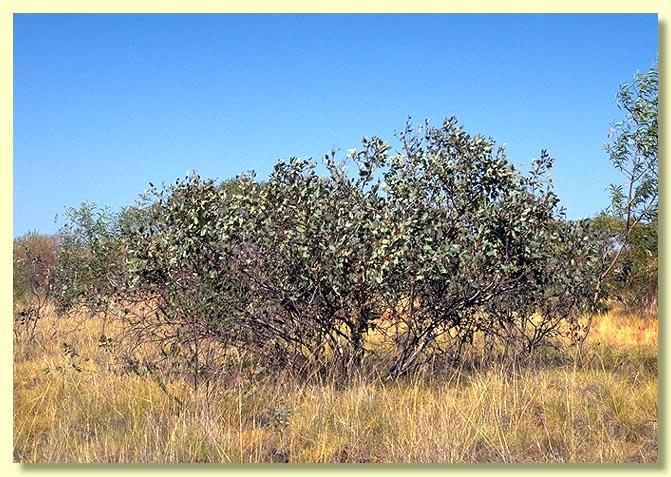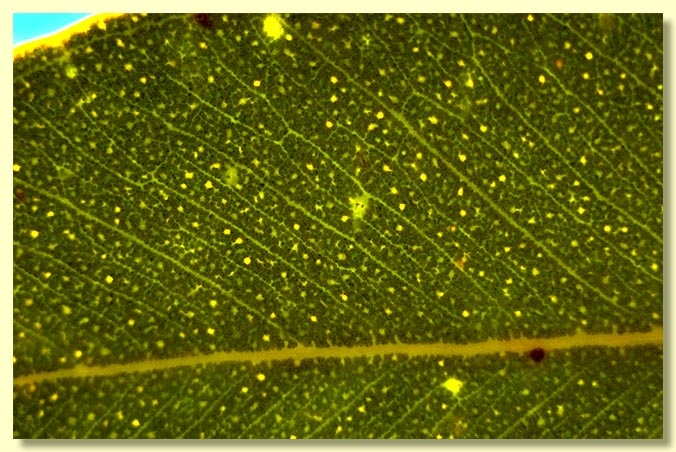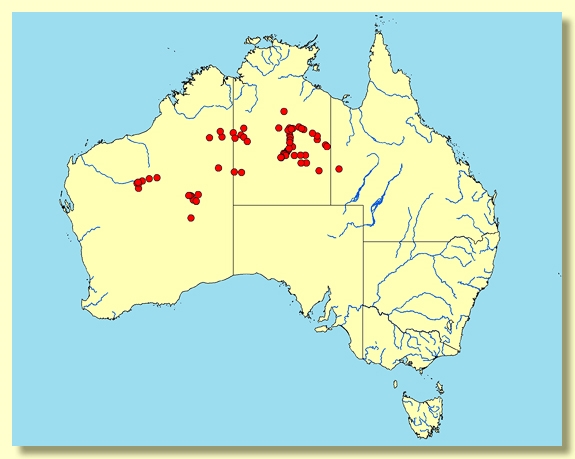Euclid - Online edition
Eucalyptus pachyphylla
Eucalyptus | Symphyomyrtus | Bisectae | Destitutae | Curviptera | Xylocarpae
Mallee to 5 m tall. Forming a lignotuber.
Bark smooth pale brown, shedding in strips to reveal silvery to pale grey-white new bark.
Branchlets lacking oil glands in the pith; non-glaucous.
Juvenile growth (coppice or field seedlings to 50 cm): stems rounded in cross-section; juvenile leaves always petiolate, opposite only for lowest nodes then alternate, coarse, ovate to lanceolate, to 16 cm long, to 5 cm wide, dull, greyish green. Wax visible only on new growing tips but not persisting as leaves expand and stems elongate.
Adult leaves alternate, petioles 1.2–3.5 cm long; blade thick, ovate to lanceolate, 6–11.5(16) cm long, (1.5)2–4.5 cm wide, base rounded to tapering, apex pointed, concolorous, green to blue-grey, side-veins at a wide angle to midrib, reticulation very dense and broken or obscure due the thickness of the leaves, intramarginal vein present, oil glands sparse, intersectional.
Inflorescence axillary unbranched, held erect or spreading, peduncles rounded to angular, 0.4–2(2.5) cm long, buds 3, pedicellate, pedicels 0.3–1 cm long. Mature buds ovoid (1.8–3.2 cm long, 1.3–2.5 cm wide), pinkish when close to flowering, with 5–7 prominent thin longitudinal ribs, scar present, operculum beaked (1.3–2.5 cm long), stamens arranged more or less obliquely or the outer oblique and the inner finally flexed downwards, anthers cuboid, dehiscing by lateral slits, style long, stigma tapered, locules 4(5), the placentae each with 8 or 10 vertical ovule rows. Flowers creamy yellow.
Fruit held erect, pedicellate, pedicels 0.3–1.5 cm long, broadly and shallowly obconical to shallowly hemispherical, 0.6–1.5 cm long, (1.2)1.6–3.5 cm wide including the ribs, disc raised and concave to oblique, valves 4(5), exserted.
Seeds grey-brown, 2–4.5 mm long, more or less flattened-pyramidal, dorsal surface shallowly reticulate, sides ridges, encircling marginal flange usually present, hilum more or less terminal.
Cultivated seedlings (measured at ca node 10): cotyledons Y-shaped (bisected); stems rounded in cross-section; leaves always petiolate, opposite for 4 to 7 nodes then becoming alternate, ovate to lanceolate, 5–10.7 cm long, 2.5–5 cm long, base rounded to tapering, dull, green, concolorous.
Flowering has been recorded in March, April, May, June, July, August, September and December.
Eucalyptus pachyphylla has ornamental potential for arid areas because of its decorative buds that turn pink before flowering, and its large creamy yellow flowers.
A mallee widespread through the central Northern Territory extending east to far western Queensland on Glenormiston station and west into Western Australia where it is found in the Great Sandy Desert, Gibson Desert and Little Sandy Desert. It occurs mostly on red sand plains with spinifex but in more western desert areas may occur on stonier sites and on drifts of red sands overlying sandstone and quartzite.
Eucalyptus pachyphylla belongs in Eucalyptus subgenus Symphyomyrtus section Bisectae subsection Destitutae because the buds have two opercula, cotyledons are Y-shaped and branchlets lack oil glands in the pith. Within this subsection E. pachyphylla is one of about 30 closely related species and subspecies forming series Curviptera which is characterised by having large buds in umbels of one, three or seven, stamens erect to oblique in bud, and fruit that are relatively large and have an ascending disc and prominent valves.
E. pachyphylla is most closely related to E. kingsmillii and E. youngiana. All have buds in threes. E. pachyphylla differs from E. kingsmillii in having a short stout peduncle that is not down-turned and fruit that are also smaller in diameter although there is some overlap in dimensions. Flowers of both E. pachyphylla and E. kingsmillii subsp. kingsmillii are pale yellowish whilst those of E. kingsmillii subsp. alatissima are pink to red. All three taxa have buds with prominent longitudinal thin ribs, with E. pachyphylla and E. kingsmillii subsp. alatissima showing the greatest development of this character. E youngiana has much larger buds and fruit on spreading to down-turned peduncles, buds that are not as prominently ribbed, and red to pink or sometimes yellow flowers. E. kingsmillii and E. youngiana are usually (but not always) rough-barked mallees or small trees whilst E. pachyphylla is usually a smooth-barked mallee that rarely may develop a short basal stocking of rough bark, especially in the west of its range in the Mt Beadell and Notabilis Hill area of the Gibson Desert.
E. pachyphylla differs from E. sessilis in having buds in threes (always sevens in E. sessilis). The buds of E. sessilis are slightly smaller and not as prominently ribbed as those of E. pachyphylla. The fruit of E. sessilis are hemispherical, broadly and shallowly obconical in E. pachyphylla. Buds and fruit of E. pachyphylla are conspicuously pedicellate whereas they are sessile or almost so in E. sessilis.
Eucalyptus pachyphylla : Greek pachy-, thick and -phyllus, leaved.















